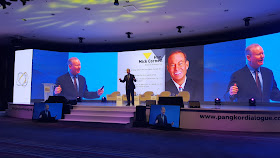13 Sept 2017
The talk by guest speaker Mike
Cornette, the mayor of Oklahoma City, USA, during Pangkor Dialogue recently on
how he has successfully transformed the
city from the second highest number of obese people 4 years ago into one of the
fittest city in USA today has triggered our memory about making Ipoh as one of
the most liveable city in Malaysia. His “The city is going on diet” campaign
has got the city with a population of over 600,000 to opt for walking instead
of driving by providing making it more walkable.
When Ipoh Mayor, Dato Zamri
Man was sworn in as the 10th mayor of Ipoh on 1st July 2015, he has
pledged to make Ipoh the most liveable city in Malaysia as his first mission.
That was exactly the same Vision Statement of Ipoh City Watch, an NGO that
represents the voice, eyes and ears of Ipoh rate payers.
According to the Economist
which ranked 140 cities throughout the world, a liveability ranking scores these
cities based on 30 qualitative and quantitative factors across five broad
categories: stability, healthcare, culture and environment, education and
infrastructure. A liveable place has affordable and appropriate housing, with
easy access to jobs, mobility options and adequate services.
Professor Rob Adams, Director of City Design
for the City of Melbourne, says liveability is about choice and access. A city
feels liveable if its citizens have choices – the choice to walk instead of
drive for example. Thus “Walkability” is one of the basic indicators of a
liveable city. Not surprising Melbourne is the most liveable city in the world
for the seventh consecutive time because it is certainly walkable, with
functioning hard infrastructure.
The Walk Score, which measures walkability,
uses a tool that measure based on the distance to the closest amenity in each
category. The highest Walk Score is given for amenities within 400m, and the
score declines as the distance approaches 1.6km. No socre is given beyond this
distance. The number of nearby amenities is the leading predictor of whether
people walk. Relevant amenities include businesses, parks, theaters, schools
and other common destinations.
While we have several parks within the city
such as the D.R. Seenivasagam Park, the Polo Ground and Gunung Lang, many this
parks are not within a walkable distance to most housing areas within Ipoh.
Ipoh City is still lacking walkways and sidewalks within city that will
encourage people to walk.
The Ipoh City Council has started planting
trees and introduced Ipoh Car Free Day 2 years ago to promote a low net carbon
emission city. Since its first launch on 18 October 2015, the Ipoh Car Free Day
has attracted thousands of people to participate in various activities. This
once in a month programme does help to create awareness among the participants.
However, this good effort must be followed with
encouraging people to abandon their cars and opt for public transportation or
take a walk to help further reduce carbon emission. Thus Mayor Mike Cornette’s talk
was a timely reminder for Ipoh City Council to relook at its efforts in
promoting walking by making the city more walkable.
One big problem faced by Ipohites is the lack
of parking space especially at the Raja Permaisuri Bainun Hospital where there
are many visitors parked their cars by the roadside. Despite having sidewalks
provided from the nearby parking space opposite the Greentown Health Clinics,
many choose to ignore. The Ipoh City Council should do more to promote walking
by providing covered walkways with pollard and enforce the use Zebra Crossing
and overhead bridge due to the extreme weather conditions and safety concern.
Trees can also be planted along these walkways within the city to provide shade
for the users.
Existing walkways in most gardens are covered
with grass which the Ipoh City Council should mobilise its staff to clear the
grass on a fixed schedule. These sidewalks are also perceived to be not safe as
there are many snatch theft cases as well as accidents happened in the past.
Along these sidewalks, pollards should be erected and planted with plants to
provide greenery.
According to Walk
Score, walkability is a measure of how friendly an area is
to walking. Walkability has health, environmental, and economic
benefits. Factors influencing walkability include the presence or absence and
quality of footpaths, sidewalks or other pedestrian rights-of-way, traffic and
road conditions, land use patterns, building accessibility, and safety, among
others. Walkability is an important concept in sustainable urban design which Pangkor
Dialogue is all about.
Of
course what Oklahoma City has done may not necessary mean it can be done the
same in Ipoh. This is because the mayor was elected and that any proposal on
spending must get the approval of the people. When majority of the people voted
to make the city walkable it can then be implemented with the people’s support
and participation.
One
good question posted during the Leadership Forum at the Pangkor Dialogue
chaired by our Menteri Besar was about what make a good and effective leader.
The answer provided by Mike Cornette was: “A good leader must be a good
listener of the people. A leader who is out of touch of the people will soon be
out of the job.”








No comments:
Post a Comment